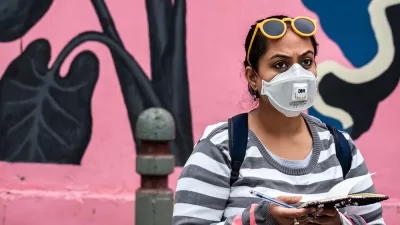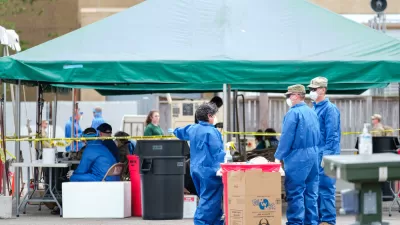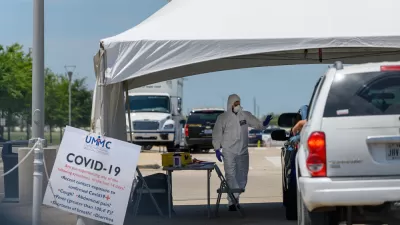A draft report from the CDC projects that new cases will grow to 200,000 and deaths to 3,000 – daily, by June 1. The model the White House coronavirus task force uses has increased the projected deaths to nearly 135,000 by early August.

"A draft government report projects covid-19 cases will surge to about 200,000 per day by June 1, a staggering jump that would be accompanied by more than 3,000 deaths each day," report and
The White House and the Centers for Disease Control and Prevention disavowed the report, although the slides carry the CDC’s logo. The creator of the model said the numbers are unfinished projections shown to the CDC as a work in progress.
The largest number of deaths in the United States in a single day since the pandemic began occurred on April 21, when 2,874 people died. (A total of 6,147 deaths were reported on April 14, but they included New York City adding more than 3,000 probable deaths to the daily total.)
Deaths have gone down considerably since then, largely due to reductions in New York and New Jersey. On May 3, the nation saw an increase of 24,715 new cases and 1,324 deaths, bringing the total to more than 1,200,000 cases and 69,900 deaths on May 4, according to the Worldometer coronavirus tracker.
"It was not immediately clear whether the projections, which also carry the logos of the departments of Health and Human Services and Homeland Security, are based on ramped- up testing, the attempt to reopen some states, the time lag between a rise in cases and deaths or some combination of those factors," add the reporters.
University of Washington model
The other new forecast released Monday comes from the Institute for Health Metrics and Evaluation (IHME) at the University of Washington which was used by the White House Coronavirus Task Force to extend the White House Coronavirus Guidelines for 30 days. When the guidelines were extended on March 31, the model indicated that deaths would range from 100,000 to 240,000. The projection dropped to just over 60,000 in mid-April due to most states enacting stay-at-home orders. The guidelines expired on April 30.
The new projection issued May 4 calls for nearly 135,000 deaths, "with a range of 95,092 to 242,890," by the first week of August, according to their May 4 press release. “This new model is the basis for the sobering new estimate of US deaths,” said IHME Director Dr. Christopher Murray.
The revised projections reflect rising mobility in most US states as well as the easing of social distancing measures expected in 31 states by May 11, indicating that growing contacts among people will promote transmission of the coronavirus.
“In each state, the evolution of the epidemic depends on the balance between relaxed social distancing, increasing temperature, and rising rates of testing and contact tracing,” said Murray. “We expect that the epidemic in many states will now extend through the summer.”
President Trump's former Food and Drug Administration (FDA) director, Scott Gottlieb, also issued a dire assessment in response to a question on CBS's Face the Nation on Sunday: "What is the direction of the epidemic?"
So there's about 20 states where you see a rising number of new cases: Illinois, Texas, Maryland, Indiana, Virginia, North Carolina, Tennessee have a lot of new cases on a daily basis. And so while mitigation didn't fail, I think it's fair to say that it didn't work as well as we expected...
I think the concerning thing here is that we're looking at the prospect that this may be a persistent spread...So the amount of days it takes for the epidemic to double in size is about 25 now, from days or less than a week at the outset of this epidemic.
Laurie Garrett, a Pulitzer Prize-winning science journalist, was asked to comment on the two new projections in her appearance on the PBS NewsHour on Monday.
[Al]though we don't have access to the raw data that they are working with, it does seem to coincide with these outbreaks that have been occurring inside of meatpacking plants, nursing homes, Veterans Administration hospitals, that have claimed large numbers of workers in those facilities, but haven't yet generalized into the larger community...
So I think they're imagining a pretty explosive set of growths, all in fairly small remote areas, and, in many cases, rural counties.
Final dire words go to Jeffrey Shaman, one of the country’s leading epidemiologists at Columbia University, who told The Washington Post:
“We don’t have the testing. We don’t have the contact tracing. We can’t detect a rebound. It’s a really problematic place to be. This is not where we want to be."
FULL STORY: Draft report predicts covid-19 cases will reach 200,000 a day by June 1

Study: Maui’s Plan to Convert Vacation Rentals to Long-Term Housing Could Cause Nearly $1 Billion Economic Loss
The plan would reduce visitor accommodation by 25,% resulting in 1,900 jobs lost.

North Texas Transit Leaders Tout Benefits of TOD for Growing Region
At a summit focused on transit-oriented development, policymakers discussed how North Texas’ expanded light rail system can serve as a tool for economic growth.

Why Should We Subsidize Public Transportation?
Many public transit agencies face financial stress due to rising costs, declining fare revenue, and declining subsidies. Transit advocates must provide a strong business case for increasing public transit funding.

How to Make US Trains Faster
Changes to boarding platforms and a switch to electric trains could improve U.S. passenger rail service without the added cost of high-speed rail.

Columbia’s Revitalized ‘Loop’ Is a Hub for Local Entrepreneurs
A focus on small businesses is helping a commercial corridor in Columbia, Missouri thrive.

Invasive Insect Threatens Minnesota’s Ash Forests
The Emerald Ash Borer is a rapidly spreading invasive pest threatening Minnesota’s ash trees, and homeowners are encouraged to plant diverse replacement species, avoid moving ash firewood, and monitor for signs of infestation.
Urban Design for Planners 1: Software Tools
This six-course series explores essential urban design concepts using open source software and equips planners with the tools they need to participate fully in the urban design process.
Planning for Universal Design
Learn the tools for implementing Universal Design in planning regulations.
City of Santa Clarita
Ascent Environmental
Institute for Housing and Urban Development Studies (IHS)
City of Grandview
Harvard GSD Executive Education
Toledo-Lucas County Plan Commissions
Salt Lake City
NYU Wagner Graduate School of Public Service





























